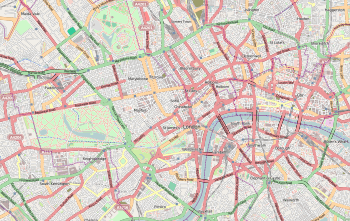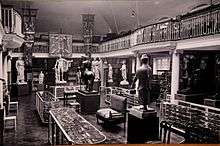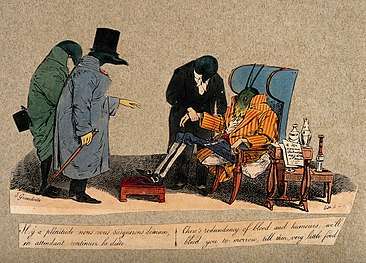Wellcome Collection
Wellcome Collection is a museum and library based at 183 Euston Road, London, displaying a mixture of medical artefacts and original artworks exploring "ideas about the connections between medicine, life and art".[2] Founded in 2007, the Wellcome Collection attracts over 550,000 visitors per year[1] and is advertised as "the free destination for the incurably curious". The venue offers contemporary and historic exhibitions and collections, the Wellcome Library, a café, a bookshop and conference facilities. In addition to its physical facilities, Wellcome Collection maintains a website of original articles and archived images related to health.[3]
 | |
 Location within Central London | |
| Established | 2007 |
|---|---|
| Location | Euston Road London, NW1 United Kingdom |
| Coordinates | 51.52582°N 0.13385°W |
| Type | Museum, library |
| Collections | history of medicine |
| Visitors | 550,000 per annum, as of 2013[1] |
| Founder | Henry Wellcome |
| Director | Melanie Keen |
| Public transit access | |
| Website | wellcomecollection |
History and development


Wellcome Collection is part of the Wellcome Trust, founded by Sir Henry Solomon Wellcome (1853–1936). An extensive and enthusiastic traveller, Henry Wellcome amassed a huge collection of books, paintings and objects on the theme of historical development of medicine worldwide. There was an earlier Wellcome Historical Medical Museum at 54a Wigmore Street, housing artefacts from around the world.[4]
The Wellcome Trust moved its administrative offices into their new Gibbs Building (designed for the Trust by Michael Hopkins and Partners) on the adjoining site in Euston Road, completed 2004: thereby creating an opportunity for a new public venue in the old Wellcome Building. The collection opened to the public in June 2007.[5]
Due to its historical holdings, the Wellcome Collection is a member of The London Museums of Health & Medicine group.[6]
Having been open since 2007, Wellcome Collection re-opened with additional public spaces in October 2015.[7]
Wellcome Library

The Wellcome Library provides access to collections of books, manuscripts, archives, films and pictures on the history of medicine from the earliest times to the present day[8]
The Hub
Located on the 5th floor of the Collection, The Hub is a space for researchers to collaborate. The first residents of The Hub, Hubbub, are exploring the dynamics of "rest, noise, tumult, activity and work" from October 2014 to July 2016.[9] In October 2016 a group exploring dementia and the arts will begin their residency.[10]
The Reading Room
Refurbished in 2015 as part of the Wellcome Collection's 2015 renovation,[7] the Reading Room is open to the public.
Collections

The collection is divided into several galleries. "Medicine Man" is a permanent exhibition displaying a small part of Henry Wellcome's collection. "Being Human" is another permanent exhibition opened in 2019 designed with the helped of disabled artists and activists within the frame of the social model of disability, making it one of the world's most accessible galleries.[11] "Being Human" explores what it means to be human in the 21st century with a focus on personal stories, and is split into four parts: genetics, minds & bodies, infection, and environmental breakdown.[12] It includes art by Yinka Shonibare CBE, Latai Taumoepeau, Kia LaBeija, and Isaac Murdoch's "Water is Life" banner designed for the Standing Rock protests.
The main exhibition space hosts a changing programme of events and exhibitions. The space has included work by Felicity Powell and Bobby Baker.
The building foyer and public areas usually include a 1950 work by Pablo Picasso[13] (originally on a wall in John Desmond Bernal's flat in Torrington Square) and one by Anthony Gormley.[14] A figure by Marc Quinn [15] was originally lying unprotected on the stone floor, then moved inside a glass case, and is also not currently on view.
References
- "Wellcome Collection London Transformation / Wilkinson Eyre Architects". 16 June 2015.
- Art Fund. "Museum of the Year". Art Fund.
- "Stories". Wellcome Collection. Retrieved 30 March 2020.
- "Error". wellcome.ac.uk.
- Photograph: Felix Clay/freelance (20 June 2007). "The Wellcome Collection". the Guardian.
- "Medical Museums". medicalmuseums.org. Retrieved 26 August 2016.
- Houghton, Lauren (23 February 2015). "Wellcome Collection to reopen after £17.5m refurb". Retrieved 26 March 2016.
- "Wellcome Library - Home". wellcomelibrary.org.
- "Hubbub 'about' page".
- "Exploration of dementia announced as second project of The Hub at Wellcome Collection". 24 March 2016.
- Marshall, Alex. "Is This the World's Most Accessible Museum?". The New York Times.
- "Being Human". Wellcome Collection.
- "Bernal's Picasso Goes On Show In London At Wellcome Collection". culture24.org.uk.
- "Antony Gormley". Telegraph.co.uk. 13 March 2007.
- White Cube. "Exhibitions - White Cube". whitecube.com.
